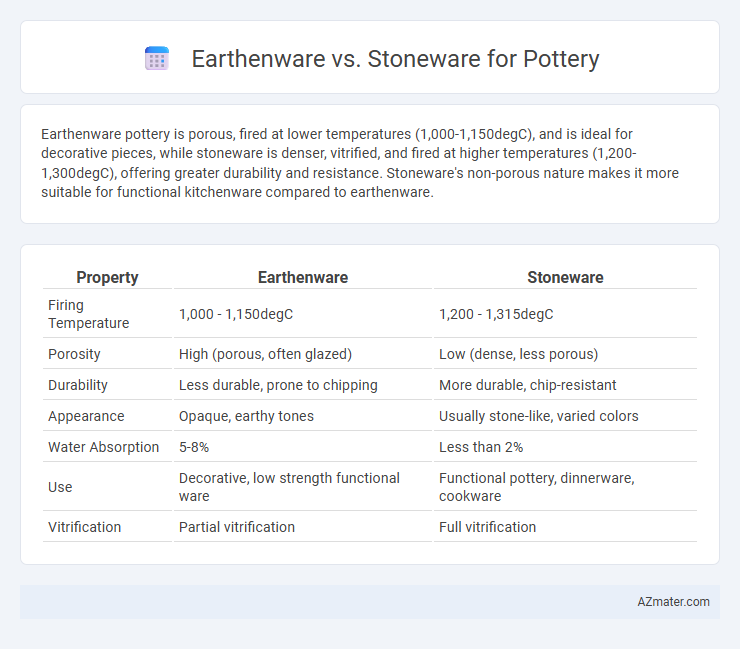Earthenware pottery is porous, fired at lower temperatures (1,000-1,150degC), and is ideal for decorative pieces, while stoneware is denser, vitrified, and fired at higher temperatures (1,200-1,300degC), offering greater durability and resistance. Stoneware's non-porous nature makes it more suitable for functional kitchenware compared to earthenware.
Table of Comparison
| Property | Earthenware | Stoneware |
|---|---|---|
| Firing Temperature | 1,000 - 1,150degC | 1,200 - 1,315degC |
| Porosity | High (porous, often glazed) | Low (dense, less porous) |
| Durability | Less durable, prone to chipping | More durable, chip-resistant |
| Appearance | Opaque, earthy tones | Usually stone-like, varied colors |
| Water Absorption | 5-8% | Less than 2% |
| Use | Decorative, low strength functional ware | Functional pottery, dinnerware, cookware |
| Vitrification | Partial vitrification | Full vitrification |
Introduction to Earthenware and Stoneware
Earthenware is a porous, low-fired pottery typically fired between 1,000degC and 1,150degC, known for its rich, warm colors and rustic appeal, making it ideal for decorative pieces and traditional ceramics. Stoneware is a dense, non-porous pottery fired at higher temperatures ranging from 1,200degC to 1,300degC, offering superior durability and strength suitable for functional wares like dinnerware and cookware. Both materials differ significantly in composition and firing temperature, affecting their texture, durability, and usability in various pottery applications.
Composition and Material Differences
Earthenware is composed primarily of clay mixed with various natural impurities and fired at lower temperatures between 1,000degC and 1,150degC, resulting in a porous, softer ceramic body often red or tan in color. Stoneware consists of a denser, vitrified clay body fired at higher temperatures from 1,200degC to 1,300degC, which makes it non-porous and more durable with a typically gray or brownish tone. The key material difference lies in earthenware's higher impurity content and lower firing range compared to stoneware's purified clays and higher vitrification, influencing both the physical properties and finished appearance of the pottery.
Firing Temperatures Compared
Earthenware typically fires at lower temperatures between 1,000degC and 1,150degC, resulting in a porous and more fragile finish, while stoneware requires higher temperatures ranging from 1,200degC to 1,300degC, producing a denser, non-porous, and more durable ceramic. The lower firing temperature of earthenware allows for vibrant glazes and decorative finishes but limits its use for functional ware requiring strength and water resistance. Stoneware's higher firing temperature vitrifies the clay body, making it ideal for everyday use, including kitchenware and outdoor pottery.
Durability and Strength
Stoneware offers superior durability and strength compared to earthenware due to its higher firing temperature, which creates a denser, more vitrified ceramic body resistant to chipping and cracking. Earthenware, fired at lower temperatures, remains more porous and fragile, making it less suitable for heavy-use applications or outdoor pottery. Choosing stoneware ensures enhanced longevity and robustness, essential for functional pottery subjected to daily wear and moisture exposure.
Porosity and Water Absorption
Earthenware typically exhibits higher porosity and water absorption rates, usually above 10%, making it less suitable for holding liquids unless glazed. Stoneware has much lower porosity, often below 5%, resulting in superior water resistance and durability without requiring a glaze. The difference in porosity directly influences their functional applications, with stoneware favored for functional pottery due to its denser, less absorbent structure.
Surface Finishes and Glazing Options
Earthenware typically features a porous, rustic surface finish, often sealed with lead-based or tin glazes that create vibrant colors and a glossy texture but require careful handling due to lower firing temperatures. Stoneware offers a denser, non-porous surface finish that supports a wider range of high-fire glazes, including matte, satin, and glossy options, making it more durable and resistant to chipping and scratching. Both types allow for decorative glazing techniques, but stoneware's ability to withstand higher kiln temperatures enhances the variation and longevity of surface finishes.
Typical Uses and Applications
Earthenware is commonly used for decorative pottery, tableware, and flower pots due to its porous nature and lower firing temperature, making it ideal for indoor use and artistic glazing. Stoneware, known for its durability and non-porous qualities after high-temperature firing, is preferred for functional items such as dinnerware, bakeware, and cookware that require strength and resistance to moisture. The choice between earthenware and stoneware depends on whether the pottery is intended for decorative purposes or heavy-duty, everyday use.
Artistic Styles and Aesthetic Qualities
Earthenware pottery features a porous, rustic texture that absorbs glazes, resulting in vibrant, earthy tones ideal for traditional and folk art styles. Stoneware offers a denser, non-porous surface with natural muted shades, perfect for modern, minimalist, and sculptural aesthetics requiring durability and subtle elegance. Both materials influence artistic expression through their distinct firing temperatures and surface qualities, shaping the visual impact and tactile experience of crafted pieces.
Cost and Accessibility
Earthenware pottery is generally more affordable and accessible due to its lower firing temperature and widespread availability of materials, making it ideal for beginners and budget-conscious artists. Stoneware requires higher firing temperatures and more specialized kilns, resulting in higher costs but offering greater durability and a broader color palette. Accessibility to stoneware is often limited by the need for advanced equipment and materials, whereas earthenware can be created using basic tools and commonly found clays.
Choosing the Right Clay for Your Pottery Project
Earthenware clay is softer, more porous, and fires at lower temperatures (1,000-1,150degC), making it ideal for decorative pottery and beginner projects. Stoneware clay, fired at higher temperatures (1,200-1,300degC), offers greater durability, water resistance, and strength, suitable for functional ceramics and items requiring long-term use. Selecting between earthenware and stoneware depends on the intended use, desired finish, and firing capabilities of your kiln.

Infographic: Earthenware vs Stoneware for Pottery
 azmater.com
azmater.com